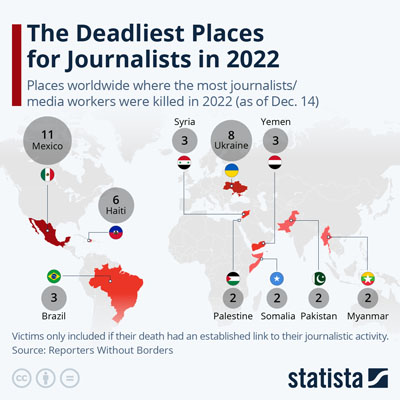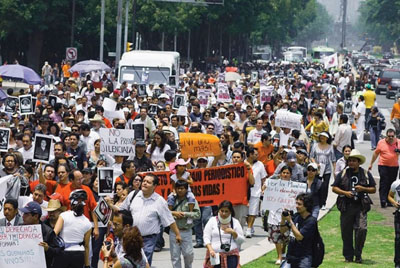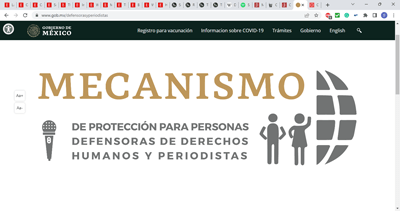On January 17, 2022, Margarito Martinez, a freelance photographer, was brutally shot and murdered in his residence in Tijuana after receiving threats for weeks but failing to get government protection. A week later, Lourdes Maldonado Lopez, a journalist in Tijuana, was shot dead in her car as she arrived home. She had previously been getting threats due to her work on corruption across the country and in politics. Despite being enrolled in Mexico’s protection program for journalists, Maldonado was still brutally murdered. This is the reality for journalists in Mexico, where journalism is an increasingly dangerous field.

Despite freedom of speech being held as an inviolable and inalienable right under the Mexican Constitution, journalists, editors, and photographers face constant threats and censorship due to their profession. Mexico has long been considered one of the most dangerous countries in the world for journalists, due to the number of killings that take place each year. As a result of this epidemic of violence against them, many journalists self-censor their work for fear of being targeted and killed, despite freedom of expression being guaranteed by the law.
Jan Albert Hootsen, the representative of Mexico for the Committee to Protect Journalists (CPJ), has been reporting in Mexico for more than twelve years. He says that the current situation in Mexico is extremely worrisome, as journalists and human rights offenders are being prevented from expressing themselves in the way that the Mexican constitution guarantees.
“Mexico is not in currently in a state of war in a conventional sense, which means that all the basic rights of its citizens and all the basic obligations of the state have not been suspended in any way, shape or form,” Hootsen said. “Yet Mexico has reached a state where violence and impunity are preventing journalists from freely expressing themselves. They are no longer able to conduct conventional journalism without running the risk of being attacked and killed.”
As a result, relevant information about Mexico has become almost impossible to access by civilians. Yet, in a country marked by corruption, human rights violations, drug violence, and political wrongdoing, journalism has become a lethal field, as it is one of the only means through which the reality of Mexican life can be unveiled.
In a country that is considered a democracy, why and how can these killings occur? How is journalism kept alive under such conditions?
The reasons for these killings, and who is responsible for them
151 journalists and media workers were killed in Mexico between 1992 and 2022, according to the Committee to Protect Journalists (CPJ). At least eleven were killed because of their work in 2022.
There is no single reason for the hostile environment that enables these killings to take place. According to Hootsen, three factors can be identified to explain the violence against journalists in Mexico.

The first relates to the epidemic of violence that can be traced back to 2006, when the Mexican government declared war on organized crime and deployed its military. This resulted in an explosion of violence across the country, Hootsen said, affecting journalists who report on the issue and damaging the vulnerable democracy. Journalists who are at the frontlines are often unable to carry out investigations on the local level, as some areas have become inaccessible due to the presence of organized criminal groups and the absence of the state which makes it too dangerous. This has great implications, as it perpetuates the corruption, impunity and abuse of power that exists in the country.
The second factor accounting for these killings is the vulnerability of journalists. According to research conducted by the CPJ, most reporters who were targeted are usually the sort of reporters in small communities who are constantly chasing the news on the street. Most of the time those who are targeted are not foreign journalists, Hootsen said, but local reporters since the killing of the former would draw too much attention from the government and result in a thorough investigation. Local reporters of small communities are targets because they are the most vulnerable and invisible.
For example, Margarito Martinez and Lourdes Maldonado Lopez, who were both killed at the start of 2022, were both local reporters from a small community in Mexico who did not benefit from the protection or attention from a foreign media outlet. They were vulnerable and thus easily killed without anyone being held responsible.
“Another thing that’s very important is that most foreign reporters in Mexico lean very heavily on the work done by Mexican reporters,” Hootsen said. “We hire local reporters as producers because they have all the context. If there is danger, it is usually Mexican reporters who are exposed and not us. We get the awards, and they get the threats. That is, unfortunately, the reality of journalists here.”
The last factor is impunity. Mexico is a country with one of the highest level of impunity in the world, in which there is too often freedom from punishment for wrongdoings. This implies that one will rarely be held responsible for the crime that they have committed. With this culture of impunity, people are encouraged to keep committing these killings as they know that they will not be punished for it.
“90% of crimes against journalists are left unresolved,” Hootsen said. “Even when they are reported to the authorities, they are never properly investigated and never lead to arrests, a court case, a trial, or sentencing. There is, therefore, no incentive for people to stop using violence.”
Who is behind these killings?
Mexico is currently in a state of unconventional war against organized criminal groups, resulting in the erosion of the Mexican justice system and the proliferation of corruption at both the local and federal levels. This implies that members of cartels have infiltrated the government and/or are working alongside authorities. As a result, it is difficult to determine who is really behind these killings.
With Mexico’s level of impunity, very few cases of journalists’ killings are solved although it seems that the motivation behind these killings is usually attributed to the journalists’ work, which usually involves investigating corruption and organized crime, including drug cartels.
This suggests that there is a big issue with corruption at both the local and state level and that journalists can be killed if they have angered someone within the government or cartels. Public perception generally assumes that gang members and cartels are responsible for these murders, yet many threats to journalists also come from corrupt politicians and the police working alongside members of organized criminal groups – the latter being ordered by the former to carry out these killings.
“During the eighties and the nineties, journalism was a risky field due to the presence of cartels and mafias. Yet now, the main sources responsible for the killings of these journalists are coming from the state level and not necessarily from the mafia cartels,” Jorge Nieto told me. He is a Mexican freelance video journalist now based in Australia but who for many years was based in Mexico and was reporting on the situation.
“We are a democratic country; we have human rights and individual rights. Yet we are seeing that state governments are changing the state rules to push the legal boundaries that protect freedom of speech,” he said. “For example, if you say something about a politician, you can go to jail in a state like Bela Cruz.”

Most of the time, the government tends to claim that these killings have nothing to do with the work journalists are conducting to avoid engaging in more comprehensive investigations, and merely say that organized criminal groups are responsible. However, there have been cases that have been investigated by the government and where it was found that the person behind the killing was a public official. This was the case for Moisés Sánchez Cerezo, a journalist based in Veracruz who turned out to have been killed under the orders of the mayor of his municipality.
Yet that is not to say that the government officials are behind all the killings.
Alejandra Ibarra, a Mexican journalist author of the book “El Chapo Guzmán: El Juicio del Siglo” and who has conducted a lot of research on the issue, explained that one of the only cases of journalist killings in Mexico that was thoroughly investigated was the Javier Valdez case in 2017. The investigation resulted in the identification of both the hitmen and the person who ordered the murder, Damasco Lopez Serrano, a drug dealer and member of the Sinaloa cartel. She explained that the trial uncovered that Javier Valdez was killed because Serrano did not like the way he had been portrayed in one of his articles.
The government’s response
The Mexican government has begun some efforts to protect journalists and human rights defenders. There is an institution called the federal mechanism for the protection of human rights defenders and journalists, known as el mecanismo, which is meant to ensure the protection of journalists who are in danger.

Nieto says that on paper the program looks good, but in practice is quite inefficient. “We are a country that on paper is a democracy that guarantees freedom of speech but in practice not much action is taken. They claim they are protecting journalists since they have this protocol, but the reality is that accessing this protocol is very hard. Even in the case where journalists manage to get protection, I know of some who cannot keep maintaining the program because sometimes they need to pay for the bodyguards, the gas, and the meals of those taking care of them.”
During his interview, he told me how Margarito Martinez, one of his colleagues and friends, started receiving threats and asked for protection from the government. Yet they were not efficient in providing him with protection as they claimed they had bureaucratic issues. The threats kept getting worse and despite being in constant communication with the group “Yo si soy periodista,” he was killed a few weeks later at his residence in Tijuana. This, according to Nieto, shows the failure and hypocrisy of the government in protecting journalists in Mexico as the program fails to do what it was intended to do.
In the three years since President Andrès Manuel Lopez Obrador took power, attacks on the press have increased by 85%. This suggests that the government may also have some degree of responsibility for the killings. Hootsen says that every morning during his press conference, the president openly criticizes and attacks the press, presenting journalists as troublemakers who are working against the government.
“This is problematic, as a president who has over fifty percent of support will result in a big portion of society adopting his mindset and views,” Hootsen said “Journalists will be seen by most as not valuable and as a threat. As a result, these killings will keep taking place.”
He says that the government is not doing enough, that the laws and institutions that have been created by the Mexican State are not sufficient as they have no preventative effect on people who target and kill reporters.
At the start of 2022, a spike in murders resulted in outrage among people affected, who demanded increased press protection and justice for those who had been killed. But despite this, there seems to be no reaction from authorities and Mexican society as a whole has not really responded to these killings in a major way.
Nieto commented on this during his interview, saying that the passiveness of Mexican society could be explained by the fact that journalists are not seen as crucial, and the killings are not viewed as attacks related to their profession but rather to the broader epidemic of violence in Mexico.
“There is a big disconnection between the community and journalists. I do not know why they feel like it is not something that is important for them. I don’t know why no people are protesting in the streets and why we are being isolated,” Nieto said. “We are relevant to the community, but we are not seen and deemed important to them. I remember in 2007 when violence was really bad in Tijuana and members of cartels started kidnapping doctors. This resulted in people taking the streets and protesting. So it’s as doctors are seen as crucial for the community, but journalists are not. I only hope we receive the value we deserve.”
How is journalism kept alive in Mexico
Under such conditions, keeping journalism alive in Mexico is a constant struggle. Yet measures have been taken to fill the gap of the government, by providing journalists with support and some form of protection during their reporting. Organizations have been created to help tackle the challenges that journalists face by providing them with assistance during their reporting in an attempt to keep them safe.
The Committee to Protect Journalists is an example of this. Hootsen, as the CPJ representative for Mexico, explained that the organization was created in the early 1980s by American journalists who realized that no sort of international framework to protect journalists existed at a time when they were being attacked. Over the years it has become a global NGO that aims to promote freedom of expression and protect journalists from repression. He said that in Mexico, CPJ tries to fill in the gaps of the government’s inefficiency by providing journalists with direct assistance in the case of risk, by getting them in contact with authorities or providing them with legal assistance and solutions that will help them be safe. The organization also engages in advocacy, trying to convince the government and public opinion that safer circumstances and conditions need to be created for journalists.
Yet these types of organizations that work to support journalists and promote press freedom within countries like Mexico also feel the effects of the violent and corrupt environment. Paula Saucedo is the protection and defence officer at Articulo 19 Mexico and Central America; Article 19 is an international organization that works to defend and promote freedom of expression worldwide. She explained that the Mexican government, which was once responsive to the organization’s requests, has not been so these past three years. As the organization is critical of the government inaction, it has suffered from negative comments by the president during his morning conferences, in which he has claimed that the organization receives money from foreign countries to attack the government.
“We have received death threats, smear campaigns and attacks on social media now more than before, since he is directly mentioning our organization as one that is attacking his government,” Saucedo said.
Losing the journalist’s work
Another problem that results from these killings is that, most of the time, the work that the journalists were working on disappeared with them, since they lacked the resources to archive it safely.
Alejandra Ibarra, a journalist and founder of Defensores de la Democracia, realized that this had become an issue when little information would come up as she tried researching these murdered journalists and their work. Ibarra created Defensores de la Democracia, which archives the results of their investigation, out of concern and despair about the crisis of violence against journalists, as a means to recover their work.
“I realized that the killed journalists were becoming a statistic, and that they were becoming known as having been killed,” Ibarra said. “So if you knew the name of one of these journalists, chances were that the only thing you knew about them was that they had been killed. This seemed very tragic to me because their legacy was becoming the crime that took their lives. So instead of us remembering them for the work they chose to do for decades, we were remembering them for what someone else did to them in the last minutes of their life.”
To change this, Ibarra sought to create a public archive to preserve their work and maintain their legacy. To ensure that the archive reached as many people as possible, a podcast was created to tell the stories of these journalists in their context.
“Defensores de la Democracia exists to recover the work of killed journalists and share it in their context so that it can best be understood for its value and contribution to Mexican democracy. The aim, in the long run, is to prevent lethal violence against local journalists in Mexico,” Ibarra said.
Despite the risks related to journalism, reporters in Mexico risk their lives daily to report on what is happening in their communities. Nieto says the state needs to publicly acknowledge that journalism is important, and stop attacking journalists during the daily press conferences.
“If the government, instead of attacking journalists, made public statements recognizing their value and a willingness to want to protect them, it would be an important development for our communities,” he said. “It will send the message that the government takes the issue of journalist killing seriously. It may result in reducing the levels of violence. The government should also put more money into el mecanismo, because for now it is not able to operate all over the country. Lastly, the government needs to stop changing the rules at the state level in order to improve the levels of impunity, as we cannot keep living in a country with 90% impunity.”

